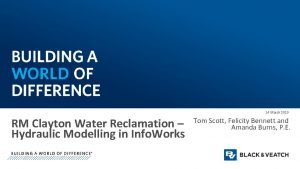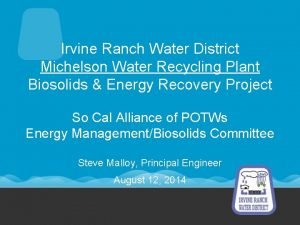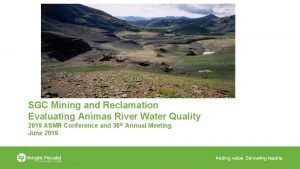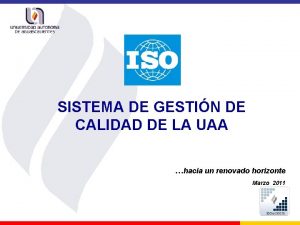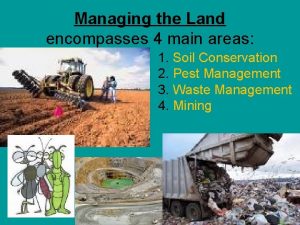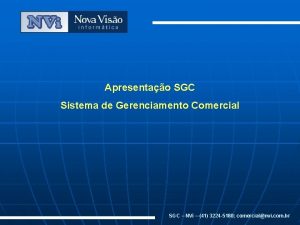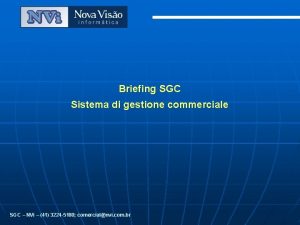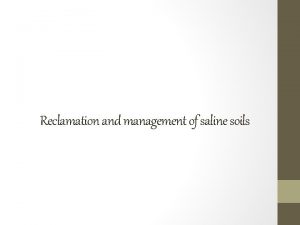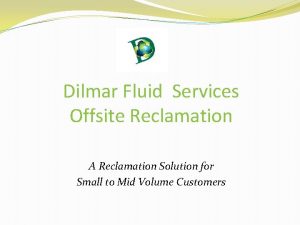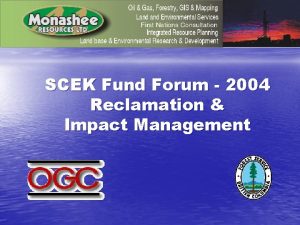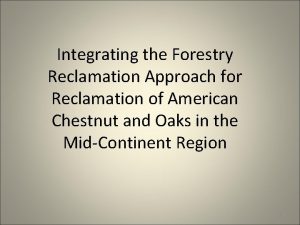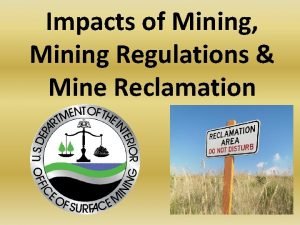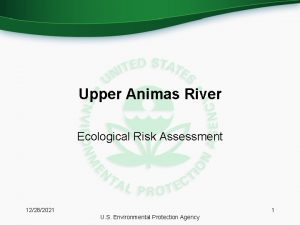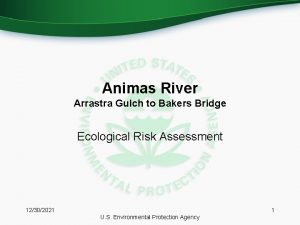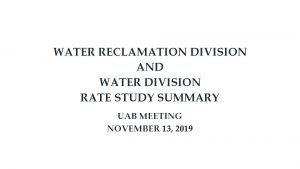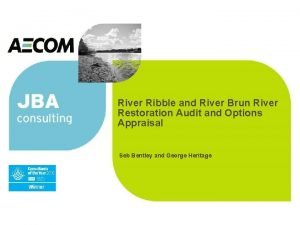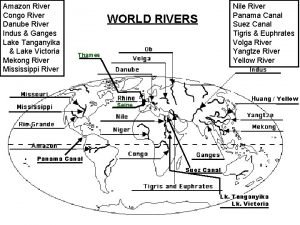SGC Mining and Reclamation Evaluating Animas River Water






























- Slides: 30

SGC Mining and Reclamation Evaluating Animas River Water Quality 2019 ASMR Conference and 36 th Annual Meeting June 2019

Overview Metals loading adversely impacts the Animas River in the area around Silverton, San Juan County, Colorado as a result of natural mineralization producing acid rock drainage in the area, compounded by historic mining activities SGC, with Agency concurrence, completed a comprehensive watershed approach to Sunnyside Mine’s reclamation SGC’s actions resulted in reduced metals loading in the Animas River and reduced impacts on aquatic life 2

Site Location Silverton Cemen t Creek Sunnyside Mine r e v i R as m i An Mi ne ral Cr ee k 3

The Challenge How to reclaim a mine site under current environmental regulations when: The mine began operation over 100 years ago under very different (or non-existent) regulatory requirements The surrounding rocks are highly altered and mineralized Massive metals loading of surface and groundwater existed premining Hundreds of abandoned mining facilities are present in the watershed 4

Geologic Setting Sunnyside Mine is approximately 8 miles north of Silverton, San Juan County, CO The area is naturally mineralized and has been for millions of years. It’s been naturally discharging heavy metals for thousands of years As a result, acid rock drainage and poor water quality were prevalent long before the advent of mining This natural metals loading in the Animas River has limited aquatic life, including trout populations downstream from Silverton 5

Historic Mining Serious mineral exploration began in the area in the early 1870 s Gold, silver, lead and copper were the main metals mined The Silverton Caldera hosted 1, 500 mines and over 50 mill sites, 8 smelters and 35 aerial trams which contributed to poor water quality An estimated 8. 6 million short tons of mill tailings were discharged directly into surface streams between 1872 -1935 In the 1970 s, regulations were established to monitor and limit metals discharges and to require miners to reclaim their sites 6

History - Sunnyside Mine The Sunnyside vein was discovered by George Howard and R. J. Mc. Nutt in 1873, and valid mining claims were staked in 1874 In November 1900, Judge John Terry obtained ownership of the mine The U. S. Smelting and Refining Company purchased the mine and mill from the Terry family in 1917 In 1959, the Sunnyside mine was leased by Standard Metals In June 1978, Lake Emma broke into the mine and emptied more than four million tons of water and mud into the workings In 1985 Standard Metals was forced into bankruptcy and the mine was purchased by Sunnyside Gold Corporation (SGC), and put back into production 7

SGC History SGC was established in 1985 SGC operated Sunnyside from 1986 until 1991 Brought all discharge permits into compliance Re-designed the mining operation Completed a substantial mine-permit amendment in cooperation with the regulatory agencies As a result, won the “Most Improved Site” award from the Colorado MLRD “The mining operation exhibited some vast improvements over the last two years. The Division would like to commend Frank Bergstrom (SGC Environment Manager at the time) for his courteous, efficient and diligent manner with which he works with our office as well as in the American Tunnel, 1998 field, as evidenced by the improvements noted, specifically at the Terry and American Tunnels. ” –Mining Land Reclamation Division, Oct. 1987 8

SGC’s 5 Years of Mining All of SGC’s mining activities used modern techniques and were under the modern era of environmental regulation SGC’s activities were regulated by the Federal and State governments, and all activities were permitted SGC treated a significant amount of water, and as a result, substantially reduced metals loading in the Animas River 9

Reclamation Approach Reclaim and restore the surface in the Sunnyside Basin Reclaim and restore the surface at the American Tunnel Portal Physically and chemically stabilize the Mayflower Tailings Control and minimize mine discharge by installing bulkheads Remediate a series of non-SGC sites in the Upper Animas Basin Compliance determined by zinc concentration at USGS Gaging Station (A-72) below confluence of Animas River, Cement Creek, and Mineral Creek 10

Key Reclamation Dates November 1993: Technical Revisions to the reclamation plan, including installation of bulkheads, approved by MLRB Fall 1994: Animas River Stakeholders Group formed and SGC becomes member May 1996: SGC and Colorado enter into a consent agreement which was approved by BLM and endorsed by EPA January 2003: Colorado Department of Public Health and Environment (CDPHE) Determines Terms of Consent Decree met 11

SGC Reclamation and Remediation Activities 12

Reclamation - Surface Facilities SGC placed 240, 000 cubic yards of clean fill over the Lake Emma Subsidence area, contoured and reseeded area SGC removed 80, 000 tons of historic mine waste and tails from the American Tunnel, contoured and reseeded the area SGC contoured the 4 Mayflower tailings piles to promote physical stability, covered with subsoil, and reseeded the area In January 1999 added projects for additional hydrologic controls of Mayflower tailings pond #4 to divert upgradient surface and groundwater around the tailings 13

Reclamation - Before & After 14

Reclamation - Before & After 15

Reclamation - Before & After 16

Reclamation - Before & After 17

Reclamation - Sunnyside Underground Between 1992 and 2002, SGC installed a series of nine engineered concrete bulkheads in the Sunnyside Mine, including the Terry and American Tunnels The primary purpose of the concrete bulkheads is to isolate the interior workings of the Sunnyside Mine, and prevent water flow from the interior workings to the surface As expected, the installation of the bulkheads caused the local water table to return toward natural levels Lime slurry was injected into the flooded Sunnyside mine workings The engineered bulkheads are stable, performing as intended, and have isolated the interior workings of the mine 18

Reclamation - Water Treatment SGC operated a plant to treat the discharge from the American Tunnel and used excess capacity to treat the flow in Cement Creek. SGC removed: Over 326, 000 pounds of metal from Cement Creek between August 1996 and December 2002 Over 290, 000 pounds of metals from American Tunnel discharge between August 1996 and December 2002, preventing it from entering Cement Creek As a result of these efforts, Cement Creek below the treatment plant had less metals loading than it would have under baseline conditions SGC also operated a treatment plant at the Terry Tunnel from 1986 -1996 when SGC installed bulkheads in the Tunnel, removing thousands of additional pounds of potential contaminants 19

SGC Water Treatment System at Cement Creek 20

Reclamation - Other Projects SGC and the State of Colorado agreed on a comprehensive watershed approach in which SGC would be released from further obligations in exchange for bulkheading various sources of mine drainage and completing several other projects in the region. Bulkheads were installed at the Mogul, Gold Prince and Koehler mines Large quantities of mine waste and historic tailings were removed, relocated and stabilized Sites were contoured and reseeded to improve stability and promote revegetation to minimize erosion 21

Other Projects - Before & After 22

Collaboration SGC is a member and active participant of the Animas River Stakeholders Group (ARSG) ARSG, working with state and federal agencies, identified 400 sites as priority contributing sources to the upper Animas River. 67 of these sources accounted for 90 percent of the metals contamination from all mining sources ARSG’s study led CDPHE to implement 27 realistic Total Maximum Daily Load standards, based on partial remediation of the priority sites ARSG has completed many of the identified projects utilizing 319 grants SGC provided a portion of the in-kind match and a disposal site for one of the projects 23

Evaluation of SGC Activities CDPHE evaluated the success of SGC’s actions based on the zinc concentrations measured at sample point A-72 (USGS Gaging Station) A methodology based on a regression analysis of flow versus concentration was employed to account for seasonal fluctuations in concentrations in response to variation in stream flows SGC met the criteria at A-72 and was released from further obligations in 2003 24

Methodology for Evaluating Zinc at A-72 Determine Zn concentration at A-72 monthly Develop regression equation for flow and zinc concentration during reference period: ln(Zn. A-72) = 8. 30 -0. 462*ln(flow)+0. 697*Rise Zn. A-72=e[ln(Zn. A-72)] Std. E Rise 0 = 0. 1460 Std. E Rise 1 = 0. 1533 Compute the standardized residual St. R = (ln[Zn. A-72 Actual] - ln[Zn. A-72 Pred])/Std. E Evaluate the trends in the data using a running average of the standardized residual 25

Regression Plot Reference Period 26

Zinc Standardized Residual Running Average 27

Ongoing Success of SGC’s Closure Method Application of CDPHE’s methodology demonstrates the continued success of SGC’s bulkheading, remediation and reclamation activities. The post closure plan included two independent aspects to maintain the zinc concentrations Successful completion of SGC’s bulkheading, remediation and reclamation Third party operation of the Gladstone treatment plant to treat water from various adits When both aspects in place, zinc targets met EPA commenced operation of the Gladstone plant at substantially less than its capacity in February 2016, and CDPHE’s zinc targets have been met since June 2017 28

Conclusions The use of bulkheads to control discharges from the Sunnyside mine, and reclamation of associated surface facilities in conjunction with removing other sources of metals loading from facilities not owned by SGC have resulted in decreased loadings to the Animas River SGC’s brief mining and extensive reclamation activities each substantially reduced metals loading in the Animas River Without the actions of SGC, metal levels in the Animas River, and the resulting impacts on aquatic life and the trout fishery downstream of Silverton, would undoubtedly be more adverse 29

Q&A Steven Lange slange@knightpiesold. com
 Atlanta rm clayton water reclamation plant
Atlanta rm clayton water reclamation plant Irvine water district
Irvine water district Water and water and water water
Water and water and water water Mine reclamation before and after
Mine reclamation before and after Sgc organizational structure
Sgc organizational structure Basler generator controller
Basler generator controller Sistema de gestion de calidad uaa
Sistema de gestion de calidad uaa Miig sgc
Miig sgc Certified hospital emergency coordinator
Certified hospital emergency coordinator Reclamation specialist
Reclamation specialist Riley doman
Riley doman Land reclamation methods
Land reclamation methods Vetac
Vetac Difference between strip mining and open pit mining
Difference between strip mining and open pit mining Difference between text mining and web mining
Difference between text mining and web mining Strip mining vs open pit mining
Strip mining vs open pit mining Strip mining vs open pit mining
Strip mining vs open pit mining Multimedia data mining
Multimedia data mining Mining complex types of data in data mining
Mining complex types of data in data mining El rayo de luna ciudad seva
El rayo de luna ciudad seva Da mihi animas caetera tolle
Da mihi animas caetera tolle Da mihi animas
Da mihi animas šaljive narodne priče kratki sadržaj
šaljive narodne priče kratki sadržaj Animas insulin pump
Animas insulin pump El monte de las animas ciudad seva
El monte de las animas ciudad seva Animas insulin
Animas insulin I am the river and the river is me
I am the river and the river is me Tukwila
Tukwila Pump it up: data mining the water table
Pump it up: data mining the water table Freshwater
Freshwater Dub denman canoe trail
Dub denman canoe trail
